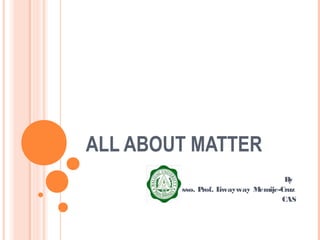
All about matter12
- 1. ALL ABOUT MATTER By Asso. Prof. Liwayway Memije-Cruz CAS
- 2. MATTER IS ANYTHING THAT OCCUPIES SPACE AND HAS MASS
- 3. CLASSIFICATION OF MATTER According to the origin or source, matter is classified as organic and inorganic matter. Organic matter comes from living things, while inorganic matter comes from non-living things. Chemists have studied that all forms of matter may be classified into three general classes on the basis of their compositions. These are the elements, compounds and mixtures. Element is a substance, which cannot be decomposed by ordinary means. Atom is the smallest part of an element that can enter into combination with other elements. Compound is a substance, which can be decomposed into two or more simpler substances by ordinary chemical means. Mixture is a material composed of two or more substances each of which retains its own characteristic properties. a. Heterogeneous mixture is one which has parts possessing different properties. b. Homogeneous mixture is one which has similar properties throughout. Substance is a homogeneous material composed of one particular kind of matter.
- 5. MATTER CAN ORDINARILY EXIST IN THREE PHYSICAL STATES – SOLID, LIQUID, AND GAS. A FOURTH STATE OF MATTER EXISTS UNDER SPECIAL CONDITIONS, CALLED PLASMA.
- 6. THE STATE OF MATTER CHANGES AS YOU ADD MORE ENERGY.
- 8. PHYSICAL PROPERTIE S Specific and accidental Specific properties are those features, which definitely distinguish one substance from another. Some of these are the following: 1. Density is the weight of a unit volume of a substance. 2. Specific gravity is the ratio of the weight of a given volume of a substance to the weight of the same volume of water at the same temperature. 3. Hardness is the ability of the substance to resist scratching. 4. Odor is the characteristics odor of a given substance. 5. Color is the characteristics color of a given substance. Accidental physical properties are those features as weight, dimensions, and volume. They have nothing to do with the nature of the substance, but they enable us to find out how much of a given substance we have.
- 9. CHEMICAL PROPERTIES Chemical properties of a substance describe how a substance acts when it undergoes change. They describe its ability to form new substances under given conditions. A chemical change or a chemical reaction is a change from one substance to another. the reactions occur. Some of the chemical properties are: combustibility, stability, relative activity, response to test reaction, and ionization.
- 10. STATES OF MATTER AND CHANGES OF STATE.
- 11. INTRINSIC AND EXTRINSIC PROPERTIES Intrinsic (intensive) Properties are properties that do not depend on the size of the sample. Examples are color, odor, boiling point, and electrical conductivity. Extrinsic (Extensive) Properties are properties that depend on the size or amount of the sample. Examples are mass and volume.
- 12. LAW OF CONSERVATION OF MASS The Law of Conservation of Mass state that mass is neither created nor destroyed. An example is shown in the complete combustion of gasoline. The relationship is true within the limits of one’s ability to determine the weights of the reacting substances and the products of the reaction: Gasoline + oxygen ----> carbon dioxide + water vapor Weight of reactants = weight of products
- 13. LAW OF DEFINITE PROPORTION The Law of Definite Proportion states that any pure compound is always composed of the same elements combined in a proportion by weight. Example: Water always contains 8 parts by weight of oxygen to 1 part by weight of hydrogen. H2O O = 16/18 x 100% = 88.88% H = 2/18 x 100% = 11.11% _____________ 99.99%
- 14. LAW OF MULTIPLE PROPORTIONS The Law of Multiple Proportion states that when the same two elements unite to form two or more different compounds, if the amount of one element is constant, the weights of the other element in the series of compounds will be in the ratio of small whole numbers. Examples: H2O = 1g of H and 8g of O H-2O2 = 1g of H and 16g of O
- 15. IDENTIFY WHETHER THE FOLLOWING ARE PHYSICAL OR CHEMICAL CHANGES: ___________________1. welding metals ___________________2. ripening of fruits ___________________3. grinding rice ___________________4. dissolving sugar in water ___________________5. burning gas ___________________6. magnetizing iron nails ___________________7. melting of butter ___________________8. hair bleaching ___________________9. souring of milk ___________________10. brewing of coffee
- 16. CLASSIFY THE FOLLOWING AS EITHER AN ELEMENT, A COMPOUND, OR A MIXTURE: ___________________1. gasoline ___________________2. dry ice ___________________3. aluminum wire ___________________4. diamond ___________________5. lead pencil ___________________6. toothpaste ___________________7. penny ___________________8. platinum ___________________9. glue ___________________10. rubbing alcohol
- 17. CLASSIFY THE FOLLOWING PROPERTIES AS INTRINSIC OR EXTRINSIC: ___________________1. volume ___________________2. density ___________________3. length ___________________4. color ___________________5. freezing point ___________________6. electrical conductivity ___________________7. mass ___________________8. odor ___________________9. boiling point ___________________10. luster
